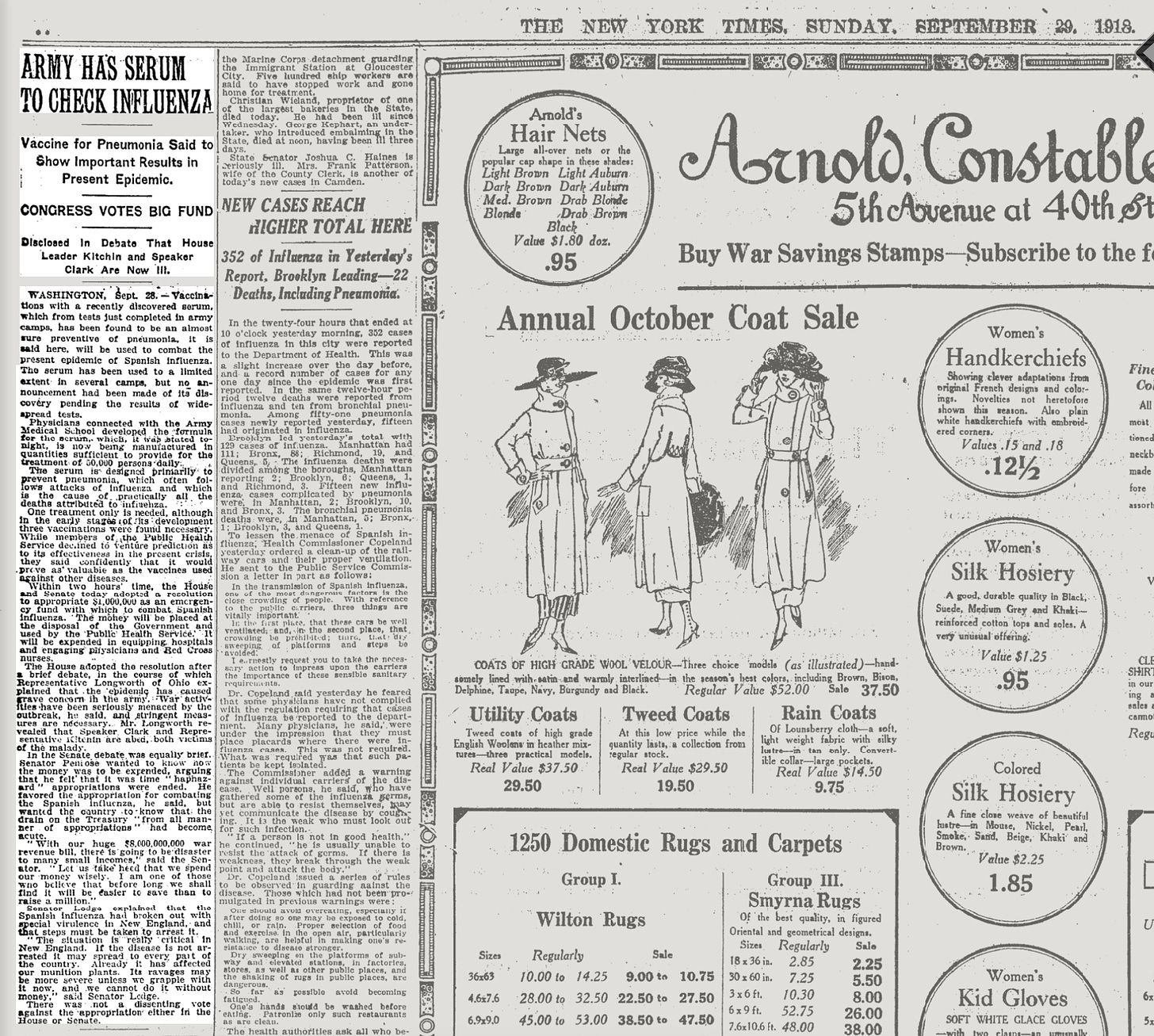Last week, I made a chilling discovery. I stumbled upon an article in the archives of the New York Times. No scholar has ever before mentioned what I found.
On Sept. 29, 1918, the New York Times reported that the U.S. Army was working on a “serum” (vaccine) to inoculate American soldiers against bacterial pneumonia in preparation for their deployment to the Front of World War I in France.
The article’s timing is critical -- the final week of September was the start of the 1918 Pandemic, which continued until the third week of November (1918) when it ended just as quickly as it appeared. (I detailed this in an article published on Medium and which I will republish here in coming weeks).
Historians know about the work of the Rockefeller Institute in January 1918 to produce a meningitis vaccine, which was tested on soldiers. However, the NY Times article is not about that vaccine; it’s specifically about a bacterial pneumonia vaccine, which, again, I’ve never seen a reference to in the academic record.
Remember -- the data is very clear that the global 1918 Pandemic occurred in autumn 1918 and lasted only 2 months. It didn’t last 18 months to 2 years as people today wrongly believe. In summer 1918, the “Spanish Flu” circulated only on the Western Front and in Spain; not globally. And the data is clear that this pathogen wasn’t fatal. People became ill, and recovered after a few weeks. There’s a huge difference between the “Spanish Flu” of summer 1918, and the disease that later struck in autumn 1918. They were two very different pathogens.
So, what happened? The established orthodoxy believes that the pathogen of summer mutated into the super killer virus of autumn 1918. However, that baseless claim does not hold up to scientific scrutiny. Naturally-occurring viruses mutate to become less lethal because its ultimate goal is to coexist with its host and not kill us.
The Sept. 29 (1918) article in the NY Times holds the key. Given the stringent war-time censorship in the USA, the NY Times most likely was reporting on a vaccine program that was already a few months old. So, we can date the Army vaccine program to at least July, if not June, of 1918.
Ironically, on the eve of the start of the global Pandemic, the NY Times praises the Army’s effort: “Vaccine for pneumonia said to show important results in present epidemic”. The vaccine “is now being manufactured in quantities” to be able to vaccinate 50,000 soldiers a day.
Given the strict Army censorship, and the lag time in publishing news in 1918, we can estimate that this information was already many weeks old when published in the Times on Sept 29.
Today, of course, we tragically know that a few days after this article was published, that in October 1918, many millions would die from bacterial pneumonia. Just what role did the Army’s vaccine for bacterial pneumonia play in igniting the autumn 1918 “influenza” pandemic?
Now, if you were living in 1918, the word “influenza” was synonymous with almost any respiratory disease, but most likely bacterial pneumonia. In fact, doctors in 1918 were not aware that viruses even existed. (Only in the 1930s did scientists finally understand that viruses exist.)
In the decades before 1918, bacterial pneumonia was a leading killer, especially among young healthy people, and especially in cities where people lived in cramped and closed apartments that often were filthy and unsanitary.
Naturally, the U.S. Army wanted to protect soldiers from any possible outbreak. In 1918, modern science was in its infancy, but scientists believed themselves gods capable of rectifying any problem with “Science”.
Now, here’s the main question — in their rush to create a vaccine against the rather benign summer “Spanish Flu” -- did U.S. Army scientists instead unleash a highly contagious and deadly Franken-disease upon the country and the world?
Scientists today know that a mass vaccination campaign must never be conducted in the middle of a pandemic. Why? Because vaccinating during a pandemic has a similar effect as the overuse of antibiotics — super-resistant strains quickly emerge and become more contagious and deadly in order to escape the vaccine’s quelling effects.
This is a phenomenon know as ADE (Antibody Dependent Enhancement). Today, scientists say we’re now seeing this with Covid-19, which is becoming more virulent, with new variants appearing, thanks to the Pfizer and Moderna vaccine.
It’s highly probable that ADE also occurred in late summer and early autumn 1918, when the U.S. Army began to inoculate American soldiers and then ship them around the world. Did the Army’s bacterial pneumonia vaccine put evolutionary pressure on the circulating Spanish Flu and intensify its contagiousness and lethality? Most likely it did. At the very least, we don’t have any other viable theory.
To repeat: I think it’s highly probable that in 1918 the U.S. Army vaccine for bacterial pneumonia backfired, triggering ADE, and thus a super-mutant strain was created. Most likely that’s what killed millions of people in autumn 1918 as the American troops and sailors spread across the world, spreading the deadly Franken-pathogen.
However, this can only be conclusively proven if we gain full and unfettered access to U.S. government and military archives, primarily the program to vaccinate the troops. But where are those vaccine program documents today? Destroyed or hidden away in a vault? Let’s go find them.
To be continued….






Great article! When I was reading it makes an impression for me, especially image of "Titanic" to fit in the way of presently situacion not only in US, the same happen in Russia just now, unfortunately. As if all planet someone made up as cage for people.
Great article! When I was reading it makes an impression for me, especially image of "Titanic" to fit in the way of presently situacion not only in US, the same happen in Russia just now, unfortunately. As if all planet someone made up as cage for people.